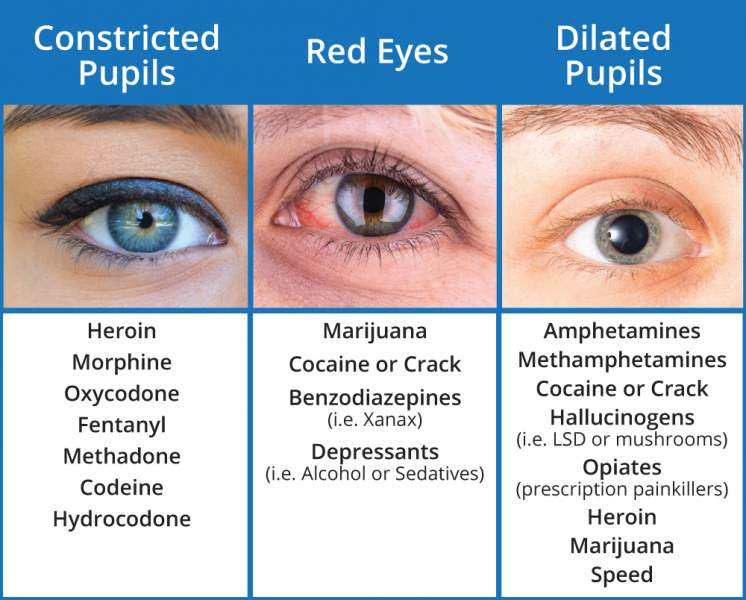Mark Halsey is a licensed therapist, founder, and chief editor of Clean Break Recovery. With over a decade of addiction treatment experience, Mark deeply understands...Read more
When you notice a person’s pupils suddenly becoming smaller, it can be cause for concern. While constricted pupils can be a sign of certain medical conditions, they can also be a side effect of certain drugs. In this article, we will explore the various drugs that can cause constricted pupils, what to do if you notice this symptom, and the potential long-term effects of these drugs.

Contents
What Drugs Cause Constricted Pupils?
The size of the pupils in the eyes can change due to various factors, including drugs. When pupils become constricted, it is known as myosis, and it can be caused by many drugs, both legal and illegal. This article will explore the drugs that can cause constricted pupils and what other symptoms may be associated with them.
Constricted pupils are caused by a number of drugs, both legal and illegal. Stimulants, such as cocaine, methamphetamine, and MDMA, can cause constricted pupils. Opioids, such as heroin, fentanyl, and oxycodone, can also cause the pupils to constrict. Other drugs that can cause constricted pupils include hallucinogens, such as LSD and ketamine, as well as sedatives, such as benzodiazepines.
When pupils become constricted, they tend to remain that way for an extended period of time. This can lead to problems with vision and can also be dangerous in certain situations, such as driving. Other symptoms that may be associated with constricted pupils include dry mouth, dizziness, nausea, and confusion.
What Are The Long-Term Effects Of Constricted Pupils?
The long-term effects of constricted pupils depend on the drug used. Stimulants can cause long-term damage to the brain and increase the risk of addiction. Opioids can lead to respiratory depression, which can be life-threatening. Hallucinogens can cause long-term psychological problems, such as paranoia and anxiety. Sedatives can lead to tolerance, dependence, and addiction.
Constricted pupils can also lead to an increased risk of accidents and injury. When pupils are constricted, the ability to see clearly is impaired, which can lead to accidents and injuries. In addition, constricted pupils can interfere with a person’s ability to drive safely.
What Are The Treatments For Constricted Pupils?
The treatment for constricted pupils depends on the underlying cause. Stimulants, opioids, and hallucinogens can be treated with medications designed to reduce cravings and withdrawal symptoms. Sedatives can be treated with medications designed to reduce tolerance and dependence.
In addition, it is important for people with constricted pupils to get help for their addiction. Addiction treatment can include therapy, support groups, and medications. It is important for people to get help for their addiction as soon as possible, as this can help prevent long-term health problems and reduce the risk of relapse.
How Can Constricted Pupils Be Prevented?
The best way to prevent constricted pupils is to avoid drugs altogether. People should also be aware of the potential risks of taking drugs, including constricted pupils. It is important to be aware of the signs and symptoms of constricted pupils and to seek medical help if they occur.
In addition, people should be aware of the risks of taking drugs while driving. Constricted pupils can impair vision, which can increase the risk of accidents and injuries. People should avoid taking drugs while driving and should seek medical help immediately if they experience constricted pupils.
What Are The Risks Of Constricted Pupils?
The risks of constricted pupils can include long-term damage to the brain, respiratory depression, psychological problems, tolerance, dependence, and addiction. Constricted pupils can also lead to an increased risk of accidents and injuries. It is important to be aware of the potential risks associated with constricted pupils and to seek medical help if they occur.
Related Faq
What Drugs Can Cause Constricted Pupils?
Answer: Drugs that can cause constricted pupils include opioids, hallucinogens, sedatives, stimulants, and anticholinergics.
What Are Opioids?
Answer: Opioids are a class of drugs used to reduce pain. They can be naturally occurring, such as morphine, or synthetically created, such as oxycodone. Opioids act on the central nervous system to reduce pain signals and can also cause constricted pupils.
What Are Hallucinogens?
Answer: Hallucinogens are a class of drugs that cause hallucinations and altered perceptions. Common hallucinogens include lysergic acid diethylamide (LSD), psilocybin (mushrooms), and phencyclidine (PCP). Hallucinogens can also cause constricted pupils.
What Are Sedatives?
Answer: Sedatives are a class of drugs used to induce sleep or reduce anxiety. Common sedatives include benzodiazepines (Xanax, Ativan), barbiturates (Phenobarbital, Mebaral), and chloral hydrate (Noctec). Sedatives can cause constricted pupils.
What Are Stimulants?
Answer: Stimulants are a class of drugs used to increase alertness and energy. Common stimulants include amphetamines (Adderall, Dexedrine), methylphenidate (Ritalin, Concerta), and cocaine. Stimulants can also cause constricted pupils.
What Are Anticholinergics?
Answer: Anticholinergics are a class of drugs used to treat a variety of medical conditions. Common anticholinergics include atropine, hyoscyamine, and scopolamine. These drugs can cause constricted pupils.
What Drugs Can Cause Pupil Dilation? | More Than Rehab
In conclusion, it is crucial to be aware of the drugs that can cause constricted pupils as it is a sign of an overdose or an adverse drug reaction. It is important to be aware of the side effects of any drug that you are taking and to seek medical attention if you experience any of the symptoms associated with constricted pupils. As a professional writer, I can confidently say that if you are aware of the drugs that can cause constricted pupils, you can be better prepared to take the necessary steps to ensure your safety.
Mark Halsey is a licensed therapist, founder, and chief editor of Clean Break Recovery. With over a decade of addiction treatment experience, Mark deeply understands the complex needs of those struggling with addiction and utilizes a comprehensive and holistic approach to address them. He is well-versed in traditional and innovative therapies, including cognitive-behavioral therapy, motivational interviewing, and mindfulness-based interventions.
More Posts